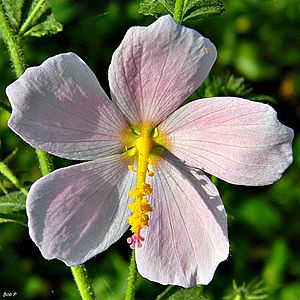Seashore mallow facts for kids
Quick facts for kids Seashore mallow |
|
|---|---|
 |
|
| Conservation status | |
| Scientific classification | |
| Genus: |
Kosteletzkya
|
| Species: |
pentacarpos
|
| Synonyms | |
|
Kosteletzkya virginica K. Presl ex Gray |
|
The Seashore Mallow (scientific name: Kosteletzkya pentacarpos) is a special kind of plant that loves to grow in salty places, like marshes along the coast. You might also hear it called the saltmarsh mallow or Virginia saltmarsh mallow. It's an herb found in different parts of the world, including the eastern coast of North America, some areas of southern Europe, and parts of Asia.
Contents
About the Seashore Mallow Family
The Seashore Mallow is a type of flowering plant. It belongs to a plant family called Malvaceae, which also includes well-known plants like hibiscus and cotton. For a long time, scientists thought the Seashore Mallow found in North America was a different species called Kosteletzkya virginica. But in 2008, they realized that the plants in North America and those in Europe looked exactly the same. So, they decided they were actually the same species, Kosteletzkya pentacarpos.
What the Seashore Mallow Looks Like
The Seashore Mallow has pretty pink flowers. It's a perennial plant, which means it lives for more than two years. It's also a halophyte, meaning it can grow well in salty soil where most other plants can't survive.
This plant can grow quite tall, sometimes over 1 meter (about 3 feet). Its leaves are usually 6–14 centimeters (2.4–5.5 inches) long. They are heart-shaped to spear-shaped with jagged edges. Both the stems and leaves of the plant are covered in tiny hairs.
The flowers are about 5–8 centimeters (2–3 inches) wide. Each flower has five petals that surround a tube made of fused stamens and style. The Seashore Mallow blooms from July to October, showing off its pale to deep pink flowers. Sometimes, people even plant it in their gardens because it's so beautiful.
Where the Seashore Mallow Grows
You can find the Seashore Mallow along the Atlantic and Gulf coastlines of eastern North America. It grows from New York all the way south to Cuba, east to Bermuda, and west to Texas.
It also grows in some parts of southern Europe along the Mediterranean coast. This includes areas of coastal Spain and Italy, as well as islands like the Balearic Islands and Corsica. Scientists think that some of the populations in northern Italy were brought there by people.
A very small group of these plants is known to grow in Georgia, on the coast of the Black Sea. You can also find them along the western and southern shorelines of the Caspian Sea in Iran and Azerbaijan. The plant is also found along the Volga and Don Rivers in southwestern Russia. It's not fully known if these Russian populations grew there naturally or if they were introduced.
Protecting the Seashore Mallow
While the Seashore Mallow is common in North America, it's quite rare in Europe and Asia. In these areas, its habitats have been greatly reduced. This is mainly due to land being used for farming and building cities. Over the past few decades, the plant has disappeared from many places where it used to grow.
How People Use the Seashore Mallow
Long ago, in a region called Transcaucasia, people collected large amounts of Seashore Mallow and another plant called Hibiscus ponticus. They used the strong fibers from the stems of these plants to make useful items like ropes and nets.
Today, studies show that the Seashore Mallow could be helpful in other ways. It might be used for phytoremediation, which means using plants to clean up soil that is polluted with salt or certain chemicals. It can also help coastal farmland turn into wetlands as sea level rises, which is important for the environment.
See also
 In Spanish: Kosteletzkya virginica para niños
In Spanish: Kosteletzkya virginica para niños


